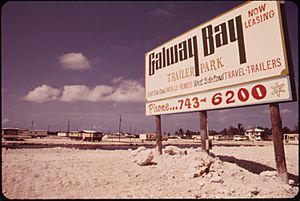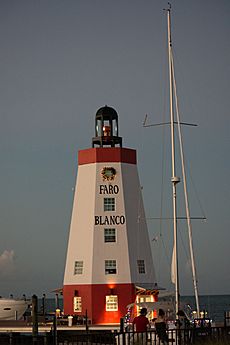Marathon, Florida facts for kids
Quick facts for kids
Marathon, Florida
|
|
|---|---|
| City of Marathon | |
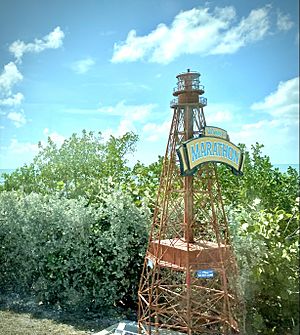 |
|
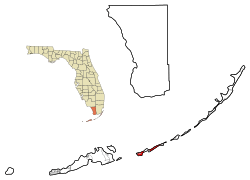
Location in Monroe County and the U.S. state of Florida
|
|
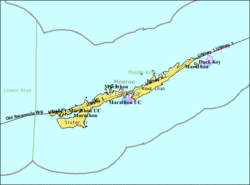
U.S. Census Bureau map showing city limits
|
|
| Country | |
| State | |
| County | |
| Incorporated | 1999 |
| Government | |
| • Type | Council-Manager |
| Area | |
| • Total | 9.28 sq mi (24.03 km2) |
| • Land | 8.45 sq mi (21.88 km2) |
| • Water | 0.83 sq mi (2.15 km2) |
| Elevation | 3 ft (1 m) |
| Population
(2020)
|
|
| • Total | 9,689 |
| • Density | 1,147.17/sq mi (442.91/km2) |
| Time zone | UTC−5 (Eastern (EST)) |
| • Summer (DST) | UTC−4 (EDT) |
| ZIP Codes |
33050−33052
|
| Area code(s) | 305 |
| FIPS code | 12-43000 |
| GNIS feature ID | 0286401 |
Marathon is a city located in the middle of the Florida Keys. It is part of Monroe County, Florida, in the United States. In 2020, about 9,689 people lived there. This was an increase from 8,297 people in 2010.
Contents
History of Marathon
Marathon is a fairly new city. It officially became a city in 1999. But people have lived in the area for a long time.
How Marathon Got Its Name
The name Marathon comes from the time when the Florida East Coast Railroad was being built. Workers were busy day and night to finish the railway. They found the work so hard and never-ending that they would say, "This is getting to be a real marathon!" This saying then gave the local train station its name.
A historian named Dan Gallager wrote a book about the railway. He said that a writer named Witter Bynner helped name Marathon. Bynner was asked to suggest names for the train stations. When he saw the area at Key Vaca, he thought of a line from a poem by Lord Byron: "The mountains look on Marathon—and Marathon looks on the sea." This inspired him to suggest the name "Marathon."
Hurricane Irma's Impact
On September 10, 2017, Hurricane Irma caused a lot of damage in Marathon. The city was one of the first places in the Keys to get help and supplies after the storm. The Air National Guard sent large transport planes to bring in needed items. They landed planes every two hours starting the day after the hurricane hit.
Geography of Marathon
Marathon is made up of several "keys," which are small islands. These islands are in the middle part of the Florida Keys. If you travel on U.S. Route 1, Marathon is about 50 miles (80 km) northeast of Key West. It is also about 54 miles (87 km) southwest of Key Largo. To the south, you'll find Hawk Channel, a popular path for boats.
The city of Marathon stretches from one end of the Seven Mile Bridge to the west end of Tom's Harbor Bridge. It includes many islands like Boot Key, Knight's Key, Vaca Key, and Grassy Key. The main business area is around Mile Marker (MM) 50 on the Overseas Highway (US 1). This is where you'll find the Publix grocery store and the post office.
The city covers about 9.28 square miles (24.03 km2) in total. Most of this area, about 8.45 square miles (21.88 km2), is land. The rest, about 0.83 square miles (2.15 km2), is water. The city's boundaries also go about 1,200 feet (366 m) into the water around the islands.
Boot Key Harbor is a natural water area located between Boot Key and Key Vaca. It is completely inside the city limits of Marathon.
Marathon's Climate
Marathon has a tropical savanna climate. This means it has two main seasons. From May to October, it is hot and wet. From November to April, it is warm and dry. It has never snowed or frozen in Marathon.
| Climate data for Marathon, Florida (Florida Keys Marathon Airport), 1991–2020 normals, extremes 1950–present | |||||||||||||
|---|---|---|---|---|---|---|---|---|---|---|---|---|---|
| Month | Jan | Feb | Mar | Apr | May | Jun | Jul | Aug | Sep | Oct | Nov | Dec | Year |
| Record high °F (°C) | 88 (31) |
89 (32) |
90 (32) |
94 (34) |
96 (36) |
99 (37) |
99 (37) |
98 (37) |
97 (36) |
96 (36) |
91 (33) |
88 (31) |
99 (37) |
| Mean maximum °F (°C) | 83.7 (28.7) |
84.6 (29.2) |
86.4 (30.2) |
88.7 (31.5) |
91.2 (32.9) |
93.1 (33.9) |
94.3 (34.6) |
94.2 (34.6) |
92.9 (33.8) |
90.2 (32.3) |
86.6 (30.3) |
84.5 (29.2) |
95.0 (35.0) |
| Mean daily maximum °F (°C) | 75.8 (24.3) |
78.1 (25.6) |
80.7 (27.1) |
84.1 (28.9) |
87.5 (30.8) |
90.3 (32.4) |
90.9 (32.7) |
91.6 (33.1) |
89.9 (32.2) |
86.2 (30.1) |
81.2 (27.3) |
77.9 (25.5) |
84.5 (29.2) |
| Daily mean °F (°C) | 70.0 (21.1) |
72.3 (22.4) |
74.6 (23.7) |
78.3 (25.7) |
81.7 (27.6) |
84.4 (29.1) |
85.2 (29.6) |
85.6 (29.8) |
84.2 (29.0) |
81.0 (27.2) |
76.0 (24.4) |
72.7 (22.6) |
78.8 (26.0) |
| Mean daily minimum °F (°C) | 64.2 (17.9) |
66.4 (19.1) |
68.5 (20.3) |
72.5 (22.5) |
75.8 (24.3) |
78.5 (25.8) |
79.4 (26.3) |
79.7 (26.5) |
78.4 (25.8) |
75.8 (24.3) |
70.8 (21.6) |
67.5 (19.7) |
73.1 (22.8) |
| Mean minimum °F (°C) | 50.4 (10.2) |
53.3 (11.8) |
57.1 (13.9) |
63.8 (17.7) |
69.8 (21.0) |
72.6 (22.6) |
73.8 (23.2) |
73.2 (22.9) |
73.1 (22.8) |
68.8 (20.4) |
60.6 (15.9) |
55.1 (12.8) |
47.7 (8.7) |
| Record low °F (°C) | 39 (4) |
40 (4) |
48 (9) |
52 (11) |
61 (16) |
65 (18) |
65 (18) |
67 (19) |
66 (19) |
56 (13) |
44 (7) |
37 (3) |
37 (3) |
| Average precipitation inches (mm) | 1.64 (42) |
1.70 (43) |
1.33 (34) |
2.11 (54) |
3.36 (85) |
4.23 (107) |
3.77 (96) |
5.32 (135) |
6.37 (162) |
5.90 (150) |
1.79 (45) |
2.20 (56) |
39.72 (1,009) |
| Average precipitation days (≥ 0.01 in) | 7.9 | 6.0 | 5.8 | 5.0 | 7.9 | 10.4 | 12.5 | 14.3 | 15.1 | 11.7 | 7.1 | 8.3 | 112.0 |
| Source: NOAA | |||||||||||||
Population of Marathon
| Historical population | |||
|---|---|---|---|
| Census | Pop. | %± | |
| 1970 | 4,397 | — | |
| 1980 | 7,568 | 72.1% | |
| 1990 | 8,857 | 17.0% | |
| 2000 | 10,255 | 15.8% | |
| 2010 | 8,297 | −19.1% | |
| 2020 | 9,689 | 16.8% | |
| U.S. Decennial Census | |||
Census Information
The table below shows the different groups of people living in Marathon. It separates people by race and also shows how many people are of Hispanic or Latino background.
| Race | Pop 2010 | Pop 2020 | % 2010 | % 2020 |
|---|---|---|---|---|
| White (NH) | 5,508 | 6,058 | 66.39% | 62.52% |
| Black or African American (NH) | 357 | 365 | 4.30% | 3.77% |
| Native American or Alaska Native (NH) | 25 | 16 | 0.30% | 0.17% |
| Asian (NH) | 90 | 84 | 1.08% | 0.87% |
| Pacific Islander or Native Hawaiian (NH) | 2 | 6 | 0.02% | 0.06% |
| Some other race (NH) | 2 | 26 | 0.02% | 0.27% |
| Two or more races/Multiracial (NH) | 89 | 230 | 1.07% | 2.37% |
| Hispanic or Latino (any race) | 2,224 | 2,904 | 26.80% | 29.97% |
| Total | 8,297 | 9,689 |
In 2020, there were 9,689 people living in Marathon. These people lived in 3,879 households, and 2,151 of these were families. In 2010, there were 8,297 people, 3,755 households, and 2,247 families.
Places of Worship
Churches in Marathon
- Calvary Baptist Church
- Church of Christ
- First Baptist Church
- Jehovah's Witnesses Kingdom Hall
- Kirk of the Keys (Covenant Order Evangelical Presbyterian-ECO)
- Marathon Baptist Church
- Marathon Church of God
- Marathon Community United Methodist Church
- Marathon Seventh Day Adventist
- Martin Luther Chapel
- New Life Assembly of God
- Saint Paul A.M.E Church
- San Pablo Catholic Church
- St Columba Episcopal Church
- The Church of Jesus Christ of Latter-day Saints
Economy and Activities
Marathon is a very popular place for sport fishing. Many boats leave the local marinas each morning. They go fishing in both the Gulf of Mexico and the Atlantic Ocean. The many coral reefs around Marathon also make it a great spot for diving, snorkeling, and spearfishing. People also enjoy "lobster tickling" here, which is a way to catch lobsters.
One of the last natural tropical hardwood hammocks in the Keys is at Crane Point Museum. This museum is just a few miles west of the Florida Keys Marathon Airport. The area near the airport is also a good place to see rare birds like the Antillean nighthawk. In the summer, you might see gray kingbirds on telephone wires. Black-whiskered vireos sing in the hammocks, and burrowing owls also live in Marathon.
Marathon's economy relies a lot on the ocean. Seafood is a main food at most restaurants.
The Fisherman's Hospital is in the western part of the city. It is one of only three hospitals in the Florida Keys. Marathon is also home to The Turtle Hospital. This special place rescues, helps heal, and then releases injured sea turtles back into the ocean.
Marathon has the tallest building in the Keys, called Bonefish Tower. It is 143 feet (44 m) tall and is on Coco Plum. The city also has Sombrero Country Club, which is the only country club in the Keys. New hotels and marinas are being built, bringing new life to Marathon.
Arts and Culture
Marathon Library
Marathon has a branch of the Monroe County Public Library System. The current library building was finished in 2021. It has many modern features compared to the older library on the island.
Education in Marathon
Students in Marathon go to schools that are part of the Monroe County School District.
Schools in Marathon
- Stanley Switlik Elementary (for grades K–5)
- Marathon Middle/High School
- Martin Luther Children's Day School
- Kreative Kids Christian Academy
Transportation in Marathon
Highways
U.S. Highway 1, also known as the Overseas Highway, runs through Marathon. This highway goes west to connect Marathon with Key West. To the northeast, the Overseas Highway connects Marathon to Homestead and Miami.
Airport
Marathon has its own airport, the Florida Keys Marathon Airport (airport codes MTH/KMTH).
Public Transportation
- The Metrobus Route 301 (Dade-Monroe Express) takes riders between Marathon and Florida City. It stops near MM 50 and the Publix store in Marathon. It also makes stops in Islamorada, Tavernier, and Key Largo.
- Key West Transit provides bus service that connects Marathon with Key West.
- Greyhound Lines buses also stop at the Marathon Airport twice a day, going both east and west.
Famous People from Marathon
- Tony Bryant, a former NFL player
- Gary Burghoff, who played Radar on the TV show M*A*S*H
- Nick Carter, a member of the Backstreet Boys music group
- Clarence Clemons, a saxophonist for the E Street Band
- Stanley Switlik, a pioneer in parachuting
- Max Yasgur, the farmer who hosted the Woodstock music festival
See also
 In Spanish: Marathon (Florida) para niños
In Spanish: Marathon (Florida) para niños


